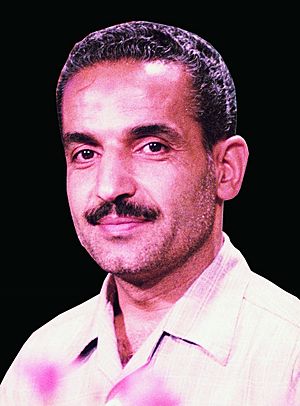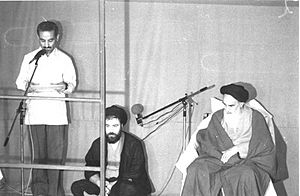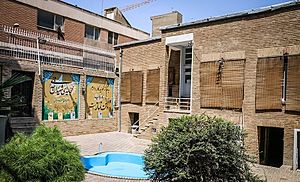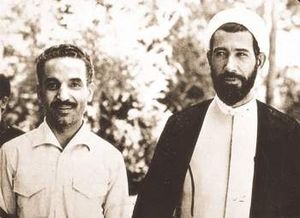Mohammad-Ali Rajai facts for kids
Quick facts for kids
Mohammad-Ali Rajai
|
|
|---|---|
| محمدعلی رجائی | |

Rajai in 1981
|
|
| 2nd President of Iran | |
| In office 2 August 1981 – 30 August 1981 |
|
| Supreme Leader | Ruhollah Khomeini |
| Prime Minister | Himself Mohammad-Javad Bahonar |
| Preceded by | Abolhassan Banisadr (June 1981) |
| Succeeded by | Ali Khamenei (October 1981) |
| 47th Prime Minister of Iran | |
| In office 12 August 1980 – 4 August 1981 |
|
| President | Abolhassan Banisadr vacant |
| Preceded by | Mehdi Bazargan (1979) |
| Succeeded by | Mohammad Javad Bahonar |
| Minister of Foreign Affairs Acting |
|
| In office 11 March 1981 – 15 August 1981 |
|
| President | Abolhassan Banisadr |
| Prime Minister | Himself |
| Preceded by | Karim Khodapanahi (Acting) |
| Succeeded by | Mir-Hossein Mousavi |
| Minister of Education | |
| In office November 1979 – 28 May 1980 |
|
| Prime Minister | Mehdi Bazargan |
| Preceded by | Gholam-Hossein Shokouhi |
| Succeeded by | Mohammad Javad Bahonar |
| Member of the Parliament of Iran | |
| In office 28 May 1980 – 1 August 1981 |
|
| Constituency | Tehran, Rey, Shemiranat and Eslamshahr |
| Majority | 1,209,012 (56.6%) |
| Head of Mostazafan Foundation | |
| In office 17 September 1980 – 30 August 1981 |
|
| Appointed by | Ruhollah Khomeini |
| Preceded by | Alinaghi Khamoushi |
| Succeeded by | Mir-Hossein Mousavi |
| Personal details | |
| Born | 15 June 1933 Qazvin, Pahlavi Iran |
| Died | 30 August 1981 (aged 48) Tehran, Iran |
| Resting place | Hafte Tir Mausoleum |
| Political party | Islamic Republican Party Islamic Association of Teachers of Iran |
| Other political affiliations |
Freedom Movement (Until 1979) People's Mujahedin (Until 1975) |
| Spouse |
Ateghe Sediqi
(m. 1958) |
| Children | 3 |
| Alma mater | Tarbiat Moallem University |
| Signature |  |
Mohammad-Ali Rajai (Persian: محمدعلی رجائی; 15 June 1933 – 30 August 1981) was an important political leader in Iran. He served as the second president of Iran for a short time in 1981. Before becoming president, he was the prime minister under Abolhassan Banisadr. He also worked as the minister of foreign affairs. Sadly, he died in a bombing on 30 August 1981, along with Prime Minister Mohammad-Javad Bahonar.
Contents
Early Life and Education
Mohammad-Ali Rajai was born on 15 June 1933 in Qazvin, Iran. His father passed away when Rajai was only four years old. He grew up in Qazvin and later moved to Tehran in the late 1940s.
When he was about sixteen or seventeen, he joined the Air Force. In 1959, he earned a degree in education from Tarbiat Moallem University. After his studies, he became a mathematics teacher.
Political Journey
Before the Islamic Revolution
After moving to Tehran, Rajai became involved in activities against the Shah's government. He worked with leaders like Ayatollah Mahmoud Taleghani. He was also part of the Freedom Movement of Iran.
Rajai was arrested more than once by the Shah's forces for his political actions. He even showed his bare foot at the United Nations to describe the harsh treatment he faced. His longest time in prison was from May 1974 to late 1978.
After the Islamic Revolution
Rajai played an active role in the Iranian Revolution. He helped lead efforts to change Iranian universities, which was later called the Cultural Revolution. After the revolution, he took on several important roles:
- Minister of Education
- Member of the Islamic Consultative Assembly (Parliament)
- Prime Minister
- President
Leading the Ministry of Education

Initially, Rajai worked as a chancellor in the Ministry of Education. When the minister resigned due to illness, Mohammad-Ali Rajai was chosen to oversee the ministry. He was later officially appointed as the Minister of Education.
His goals for education included:
- Making sure resources were shared fairly among schools.
- Improving how teachers were trained.
- Creating a school system that fit Muslim society.
- Encouraging good behavior among teachers and students.
- Building strong relationships between parents and teachers.
He worked as Minister of Education for nine months. During this time, he focused on making all schools consistent. He also worked to reduce differences between schools and change textbooks to include more Islamic teachings.
Becoming Prime Minister
In 1979, Rajai left the Freedom Movement. After the Iranian Revolution, he became the Minister of Education in the government led by Mehdi Bazargan. Even when Bazargan's government resigned, Rajai stayed in his role.
On 12 August 1980, he became the Prime Minister. This happened after Abolhassan Banisadr became president and nominated Rajai for the position. The parliament then voted him in. During his time as prime minister, the Iran–Iraq War began. His government's main focus became "victory and defense." He served as prime minister until 2 August 1981.
Serving as President
After President Banisadr was removed from office, a special council was formed. Rajai was one of its members. He then decided to run for president in the 1981 presidential election.
He won the election with 91% of the votes, becoming the first president from the Islamic Republican Party. He officially became president on 2 August 1981. He then chose Mohammad-Javad Bahonar to be the next prime minister, and parliament approved him.
His Passing
On 30 August 1981, President Rajai was holding a meeting with the Supreme Defence Council. Prime Minister Mohammad Javad Bahonar was also there. During the meeting, a trusted aide brought a briefcase into the room. The briefcase contained a bomb, which exploded, causing a fire. President Rajai, Prime Minister Bahonar, and three other people died in the attack.
The person responsible for the bombing was identified as Massoud Keshmiri. He was part of a group called the People's Mujahedin of Iran. Rajai was laid to rest in Behesht-e Zahra.
His Beliefs
Mohammad-Ali Rajai believed that the government should follow Islamic law. He thought that leaders should be Muslim and that the government should work closely with groups like the Islamic Revolutionary Guard Corps. He respected people's freedom as long as it did not go against Islamic law. He worked hard to create a stable government during his time in office.
Images for kids
See also
 In Spanish: Mohammad Alí Rayaí para niños
In Spanish: Mohammad Alí Rayaí para niños





